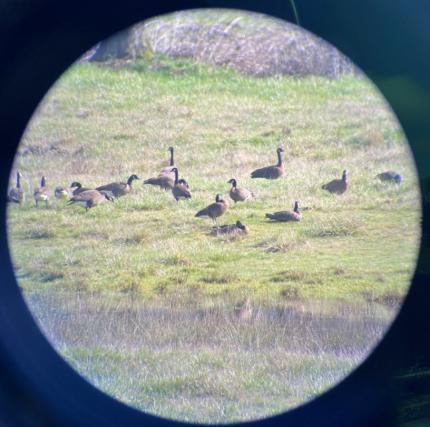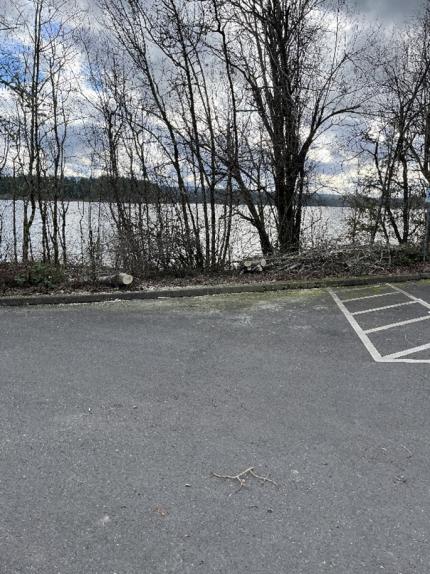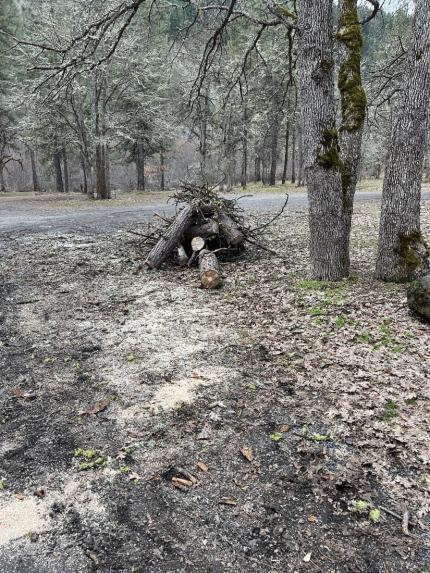Managing Wildlife Populations
Bat Hibernacula Surveys: Biologists Wickhem, Stephens, Bergh, and Holman along with Private Lands Biologist Grey and Assistant Regional Wildlife Program Manager Hauswald joined with staff members from the U.S. Forest Service and several volunteers to conduct bat hibernacula surveys in the Gifford Pinchot National Forest and adjacent private lands. The effort was organized and led by Wildlife Diversity Division Species Lead Tobin and Wildlife Diversity Survey Section Manager Cotten participated as well.
The teams skied, snowshoed, snowmobiled, and hiked several miles and surveyed many caves where they counted and identified species of bats roosting in each cave. When bats from the genus myotis were found within reach, the bats were directly swabbed to test for the fungus that causes white-nose syndrome. These surveys are part of a larger effort to survey a portion of the more than 600 caves within the Gifford Pinchot to see which support hibernating bats. They are especially interested in Townsend’s big-eared bats which are a Washington Species of Greatest Conservation Need (SCGN) and a Priority Species under Washington Department of Fish and Wildlife’s Priority Habitats and Species Program.
Thanks to Biologist Tobin for her organizational focus, many outdoor skills, attention to safety as well as biosecurity to address potential transmission of white-nose syndrome, knowledge of all things bats, and overall leadership on this large-scale effort.




Dusky Canada Goose Surveys: Biologists Wickhem continued dusky Canada goose surveys on the Shillapoo Wildlife Area and surrounding lowlands of Clark County. Biologists Stephens and Holman continued the twice-monthly surveys in Cowltiz and Wahkiakum counties. During the early February survey, Regional Wildlife Program Manager Jonker joined the Cowlitz County survey.
Dusky geese are a sub-species of Canada goose that spend summers in Alaska and migrate through and/or overwinter in the lower Columbia River. Duskys are closed to recreational harvest due to low population levels. The purpose of the surveys is to count dusky geese observed and read alphanumeric codes on any red-collared duskys.
Wildlife managers survey the geese multiple times across their primary wintering grounds in southwest Washington and northwest Oregon, then use the data to generate survival estimates. Biologist Wickhem recorded 179 dusky geese and read 12 collars on her survey. Additionally, during this period Shillapoo Wildlife Area Assistant Manager Breitenstein was able to locate and read the neck collars of nine dusky geese. Dusky, cackling, western, and greater white-fronted geese as well as both tundra and trumpeter swans were all observed during this survey period.
Thanks to Regional Wildlife Program Manager Jonker and Wildlife Area Assistant Manager Breitenstein for their contribution to this effort.



Treponeme-associated Hoof Disease (TAHD) Hoof Collection: Wildlife Conflict Specialist Aubrey and Customer Service Specialist Splitgerber responded to a report of an elk tangled up in a fence line along the road. By the time the elk was reached, it had broken free from the fence, but was not able to stand up. Aubrey suspected the elk had TAHD. After observing for a few minutes, Aubrey determined the elk needed to be euthanized. Both back hooves were infected, and all hooves were collected and transported for Washington State University’s ongoing research on TAHD.
Providing Recreation Opportunities
Silver Lake: Natural Resource Technician Celaya encountered a down tree in the Silver Lake parking lot. Fortunately, no serious damage was caused, and the tree was cleaned up within an hour, allowing ADA parking to be used unimpeded.


Site Cleanup in Klickitat County: Natural Resource Technician Celaya encountered a tree that fell at the Mineral Springs access site. The tree was first found hung up on a nearby oak. Celaya determined it was unsafe to remove the tree without additional help at the remote site. On a later date, Celaya returned with the help of Biologist Risley to clean up the tree.

Providing Conflict Prevention and Education
District 10 Terminally Ill Damage Hunt: Wildlife Conflict Specialist Aubrey worked with the Wildlife Program to find a hunting opportunity for a terminally ill hunter. Aubrey was able to send the hunter to a landowner experiencing damage to agricultural crops from elk. The hunter was successful in harvesting a cow elk on the first day at the property. It was reported to have been a limping elk, and after the hunter harvested the animal, he contacted Aubrey to ask if Washington Department of Fish and Wildlife needed the hooves. Aubrey met with the hunter to collect the hooves the following morning and transported them to Washington State University for ongoing research.